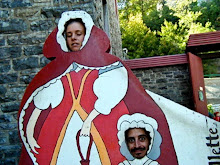We live on 2/3 of an acre in northern Vermont, on the shore of Lake Champlain. About 1/4 of an acre is available to us for growing food. No complaints here though, everything is beautiful even when you're not in the mood. Our soil is straight clay, which acts hard and compacted most of the time. When it rains too much, we get that kind of smooth slippery mud that potters use to form their vessels. When that mud dries, envision cracked desert earth that behaves like concrete. Needless to say, in terms of gardening, this is like a cruel joke. Clay soil can be improved upon over several years by adding organic matter and soil amendments -just mixing in sand is not an actual solution. After having a one season family garden for about 12 years, we started adding raised beds each year for the last 3 years. We filled them with peat moss, compost, vermiculite, rotted hay, topsoil, our own clay - whatever we could to make a looser mix. This was not cheap, most of the compost was from dairy farms and full of weed seeds, and I am so glad that the majority of this work is behind us.
 However.... these beds are awesome! So far, everything we've planted seems to thrive and can be put in fairly early. Soil warms faster in the beds, and unlike clay, a rainy Spring does not prevent you from working in them (you cannot work wet clay without ruinous results when it dries.) Our past efforts for a Spring garden were pretty laughable, but recently I've been able to plant in April. I can grow carrots - I can't even believe it! Today is October 9th, and I still have beautiful eggplant, summer squash, and peppers outside. We threaded soaker hoses through a grid of beds so that we could just turn a knob and walk away. Although it wasn't a terrible idea, this one long hose (three 50 foot sections) drowns the first bed by the time you notice the last bed getting any water. You could plant accordingly so that your water loving plants are at the beginning of the run, but in hindsight it would be better to have control over individual sections. I did mark each bed where the hose connections are made, so fixing things later won't be so heinous.
However.... these beds are awesome! So far, everything we've planted seems to thrive and can be put in fairly early. Soil warms faster in the beds, and unlike clay, a rainy Spring does not prevent you from working in them (you cannot work wet clay without ruinous results when it dries.) Our past efforts for a Spring garden were pretty laughable, but recently I've been able to plant in April. I can grow carrots - I can't even believe it! Today is October 9th, and I still have beautiful eggplant, summer squash, and peppers outside. We threaded soaker hoses through a grid of beds so that we could just turn a knob and walk away. Although it wasn't a terrible idea, this one long hose (three 50 foot sections) drowns the first bed by the time you notice the last bed getting any water. You could plant accordingly so that your water loving plants are at the beginning of the run, but in hindsight it would be better to have control over individual sections. I did mark each bed where the hose connections are made, so fixing things later won't be so heinous.Last September we put up this 10 x 32 foot Hoophouse to extend our growing season, with the hopes of keeping dormant greens to harvest throughout the winter. Did I mention those 'er , failures'? First of all, the Hoophouse was set over 3 existing 4 x 8 foot beds, positioned the long way with 2 feet of space in between each. - hence the required 32 foot length. The long side of the greenhouse faces South. Most growers position their greenhouses so that the sun rises on one long side and sets on the other, giving their beds an equal shower of light. No can do at our place thanks to trees, our pre-existing bed placement, and our devil may care attitudes. Also, our prime goal is wintertime greens not summertime tomatoes, so solar heat gain is a big plus.
Other things you'll find on this blog include lots of recipes and garden related art/building projects. I am constantly cooking - experimental fare, big batches of food for the freezer, greens a million different ways, works-of-art-sandwiches, and anything miniature. Mostly vegetarian; I like that it's cheaper, and I have to keep up with all of those vegetables we grow. Additionally, we have lived in a unfinished, un-sided house for 2 years, but can't seem to stop working outside on our garden structures. Our chicken coop has really nice siding...
One last comment on both greens and art. Greens are an amazing food source and a great addition to our daily diet - especially if not off a truck from thousands of miles away. In her book Green for Life, Victoria Boutenko makes mention of how science often uses chimpanzees to understand the effects of a western diet on our closest relative - yet has failed to observe their natural diet and how that may be a real lesson in eating to us humans. Chimpanzees eat a diet of 25 - 50% raw greens (with the rest being fruit, and a bit of nuts, seeds, and bark.) Food for thought, yes definitely. Major life change? Probably not realistically (in fact I once tried for a few weeks and came away with months worth of irritation inside my mouth and throat. However, the raw part was most likely the culprit of my allergic reaction!) Regardless, I think that eating greens everyday is a great goal for any human. And they are easy enough to grow with a few simple environmental controls - which is where the 'art' part comes in. My meaning here is to navigate around costly go-to techniques that you're likely to come across, and find your solutions by giving it some thought. Somehow, everyone should be able to grow themselves some greens for less money than buying them at the store. And free themselves from the chemical - laden and/or vitamin-deficient ones available (if you live in a place where that's your only choice at certain times of the year, like I do) even if your only solution is to sprout seeds. Sprout away, then.
So, thanks for stopping by! All are welcome and I promise to keep things PG-13. I have some terrible habits of swearing like a truck driver, and mentioning politics and religion when it's most inappropriate, but I will make a concerted effort to stick to the art and the greens. Maybe. If I can. We'll see...
Oh I spoke too soon! In the short time it's taken me to write and edit this, I already have 2 followers - a Polygamist and someone called 'Popester.' I'll never make it in the polite world of stick-to-the-subject closed-mouth blogging - wish me luck...






















No comments:
Post a Comment
Please feel free to leave a message. Haikus are always appreciated.